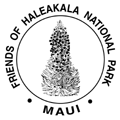|

Photo by Christa Matthews
News
Summer, 2023 Newsletter (pdf)
August, 2022 Newsletter (pdf)
Fall, 2021 Newsletter (pdf)
Spring, 2020 Newsletter (pdf)
Fall, 2019 Newsletter (pdf)
Spring, 2019 Newsletter (pdf)
Fall, 2018 Newsletter (pdf)
Spring, 2018 Newsletter (pdf)
Fall, 2017 Newsletter (pdf)
Spring, 2017 Newsletter (pdf)
Fall, 2016 Newsletter (pdf)
Spring, 2016 Newsletter (pdf)
Fall, 2015 Newsletter (pdf)
Spring, 2015 Newsletter (pdf)
Fall, 2014 Newsletter (pdf)
Spring, 2014 Newsletter (pdf)
Fall, 2013 Newsletter (pdf)
Fall, 2012 Newsletter (pdf)
Spring, 2012 Newsletter (pdf)
Fall, 2011 Newsletter (pdf)
Fall, 2010 Newsletter (pdf)
Spring, 2010 Newsletter (pdf)
Fall, 2009 Newsletter (pdf)
Spring, 2009 Newsletter (pdf)
Fall, 2008 Newsletter (pdf)
Spring, 2008 Newsletter (pdf)
A Group of Volunteers Dedicated to Preserving
Haleakala National Park for Future Generations
by Mary Evanson
It has often been said that the setting aside of significant public lands for National Parks was the best idea America ever had. In 1872 Congress established a public land policy to set aside lands for public parks or "pleasuring grounds' for the benefit and enjoyment of the people. The West was still a bit wild and unruly in those days and many of these public lands were exploited and abused.
In 1916 through an act of Congress, the National Park Service was established to promote and regulate the areas known as national parks, monuments, and reservations. The Park Service was formally instructed to "conserve the scenery and the natural land, historic objects, and the wildlife therein, and to provide for the enjoyment of the same in such manner and by such means as will leave them unimpaired for the enjoyment of future generations."
In the same year that the National Park Service was established, 1916, Congress acted to establish a national park in the Territory of Hawaii. Land on the island of Hawaii and on the island of Maui was dedicated and set apart as "a public park for the benefit and enjoyment of the people of the United States." This park was known as Hawaii National Park until 1960 when the "detached portion of Hawaii National Park was established and named Haleakala National Park."
Haleakala National Park is Maui's number one tourist destination. The Park is significant because it represents highly diverse volcanic, geolo6cal, and biological habitats ranging from over ten thousand feet elevation to sea level. It is one of the few relatively intact remnants of a unique and disappearing Hawaiian biota [animals, plants, etc. of a region] found no where else in the world. It contains abundant archaeological and historical remains of the pre-European contact civilization. It also offers miles of hiking and horse trails, campgrounds and three wilderness cabins.
As the number one visitor attraction on Maui, Haleakala is touted as "the only place on the planet where you can ride a bike from the top of a 10,6000 foot volcano to sea level covering 34 miles." The parking lot at the top of Haleakala is often packed with bike tour equipment as well as tour buses and vans, and the buzz of helicopters prevails. The visitor count is steadily climbing, and there is mounting concern about preserving this special environment that draws our visitors.
To address these concerns and to help the National Park staff in these days of lean budgets, a group named Friends of Haleakala National Park has been formed. As a Hawaii non-profit corporation, this group's purpose is to provide educational, cultural, research and service activities relating to the Park, and its ecosystems. The group will plan many volunteer activities including service projects for alien plant control ', trail work, cabin clearing/painting, as well as activities that will support the Park and the staff. Educational events will include field trips and outings with emphasis upon concern for the cultural significance and the responsible use of the Park and its surrounding areas.
An environmental center within the Park has been in the planning stages for years, arid now through major fundraising efforts, the Friends would like to make the center a reality.
Friends of Haleakala National Park
P.O. Box 322 ~ Makawao, HI 96768
(808) 876-1673 ~
|

